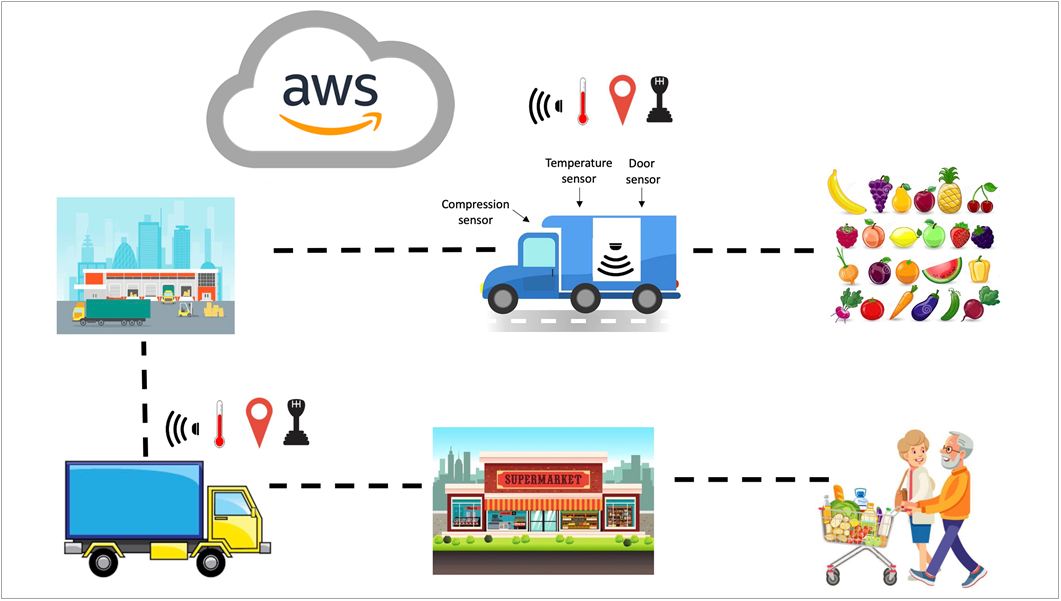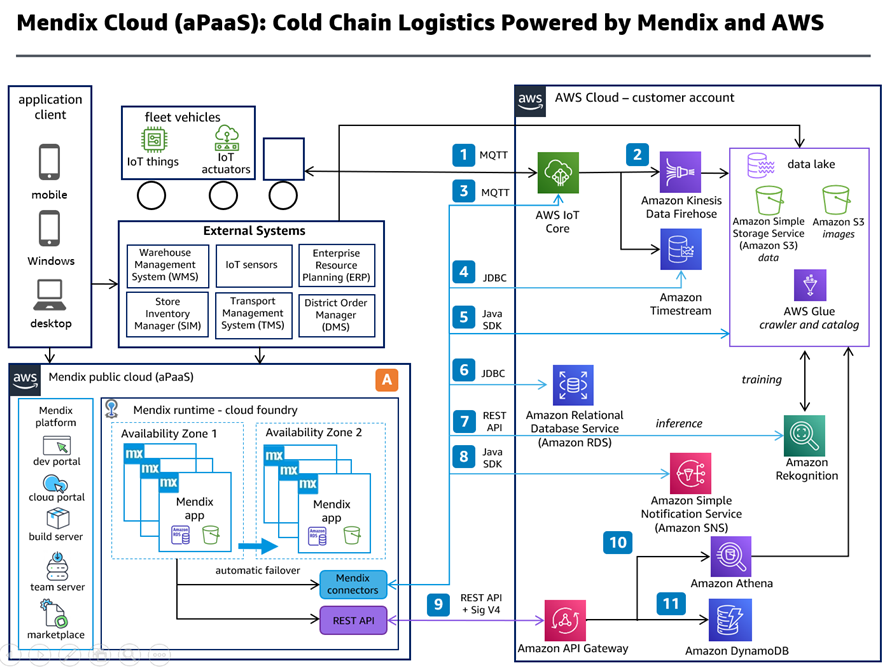AWS Partner Network (APN) Blog
Mendix and AWS Drive Development of Cold Chain Logistics with Environmental and Economic Goals
By Viktoria Semaan, Sr. Partner Solutions Architect – AWS
By Abhijeet Mukkawar, Director, Global Industry Solutions – Mendix
 |
| Siemens |
 |
Have you ever wondered how your local market gets its fresh produce? You likely know that food—like nearly every other product—is tied to a rather sophisticated supply chain.
What you may not know is that food, as a high-yield consumable, has a rather high-tech supply chain for a very non-tech, everyday product.
Think about the last time you saw a display of fresh, shiny apples at your local market. Apples, like much of the fresh food in the United States, unfortunately involves a great deal of waste to maintain its pristine offering of the most appealing fruit.
According to estimates from USDA’s Economic Research Service, 30-40% of the entire U.S. food supply is wasted every year—with 40% of this loss occurring during the supply chain.
To battle this problem and create more sustainable solutions that yield less food loss and waste, Mendix and Amazon Web Services (AWS) worked together to help suppliers develop connected and transparent logistics. Mendix is a leading low-code application development platform owned by Siemens, an AWS Industrial Software Competency Partner.
In this post, we will explain how organizations can leverage the Mendix low-code platform, AWS Internet of Things (IoT), and artificial intelligence (AI) and machine learning (ML) services to manage logistics of temperature-controlled products. The goal being to maintain quality and safety from the point of origin through the distribution chain to the final consumer.
Cold Chain Logistics: Challenges and Requirements
Cold chain is the transport of temperature-controlled goods, such as beverages and bio-pharmaceutical products, like the COVID-19 vaccine.
Companies handling temperature-sensitive products face many challenges to ensure damage-free transportation of the goods. Common challenges include limited traceability and visibility of the condition of the transported goods, inability to predict and prepare for delays, inconsistencies in the flow of data from the parties involved, and inefficiency in processing and managing data.
During logistics routes, changes in temperature, humidity, light, and vibration can occur at any point—impacting the quality and conditions of transported goods. Cold chain companies require technical capabilities to provide end-to-end visibility of their supply chain. Key components for building a transparent intelligent logistics solution include the following:
- Mobility: Real-time tracking and tracing of logistics routes provide updates to supply chain participants in multiple locations. Mobile apps have facilitated communication that enable cold chain handlers to make informed decisions.
- IoT sensors: IoT devices and sensors play an essential role in transmitting required parameters for monitoring. For example, temperatures can be measured to exact degrees for particular goods, alerting teams when the temperature has fallen outside of acceptable norms and allowing them to take preventative action.
- GPS-tracking: Real-time location tracking provides insights into transportation routes. It can be used to optimize the delivery schedule by selecting routes that reduce fuel consumption and time required to complete the route.
- Automated alerts and continuous data streams: Alerting stakeholders ensures timely actions can be taken to avoid issues. This includes predicting equipment failures, improper transportation conditions, and notifying personnel to take prescribed mitigation steps.
- AI/ML: Machine learning models that continuously analyze billions of data points collected throughout the supply chain are used to identify anomalies and trigger exception handling processes, such as additional quality assurance using AI image recognition.
- Historical insights and data lakes: Data lakes connect disparate planning and execution systems; aggregating an organization’s available data from different sources, including real-time IoT data, external data, and unstructured data with images and videos.
Figure 1 – Cold chain logistics overview.
Why Mendix and What is Low-Code?
AWS and Mendix announced a collaboration around digital transformation. The Mendix platform that runs on AWS makes it possible for companies to build mobile and web applications 10 times faster with fewer resources.
To accelerate the development process, Mendix uses a low-code visual approach to software development. Visual development empowers developers of varying skill sets to build solutions and enables non-technical domain experts to ideate and iterate rapidly.
According to Gartner, “By 2024, low-code application development will be responsible for more than 65% of application development activity.”
In addition to rapid application development, one of the strengths of the Mendix platform is its ability to abstract complex (enterprise) integrations with external systems. The Mendix Marketplace includes various enterprise connectors and adapters.
Seamlessly integrate Mendix applications with standard SAP enterprise resource planning (ERP) systems or other functional components of your supply chain systems. This includes external warehouse management systems, transport management systems, enterprise databases, and IoT devices that provide end-to-end visibility to parties in the supply chain.
Reference Architecture for Cold Chain Applications
Mendix and AWS published a reference architecture to guide organizations on how to streamline their supply chain and keep all moving parts connected and optimized using low-code Mendix applications and AWS services.
The Mendix Cloud is a platform-as-a-service (PaaS)-based cloud architecture built on AWS. Mendix applications run within fully isolated containers, consuming PaaS services, like databases and storage. For each region, the Mendix Cloud architecture is highly available and divided into multiple AWS Availability Zones (AZs). This means there’s a fully reliable offering for disaster recovery.
Mendix applications use connectors to integrate with external systems as well as various AWS services to connect different providers of the supply chain and provide transparency. Fleet vehicles transmit IoT sensor data over MQTT protocol and ingested into AWS IoT Core. MQTT is a lightweight and widely adopted messaging protocol that is designed for constrained devices.
The cold chain logistics solution uses the following AWS services:
- AWS IoT to connect billions of IoT devices, including environmental and vehicle sensor data (for example, temperature and location).
- Amazon Kinesis Data Firehose to send IoT data to a data lake.
- Amazon Timestream to save IoT and operational data in serverless time series database.
- Amazon Simple Notification Service (Amazon SNS) to notify merchant, customer, and supply chain partners about possible issues or delays.
- Data Lake on AWS to remove silos by connecting external enterprise systems.
- Amazon Rekognition to automate quality control and damage assessment using AI-image analysis.
- Amazon Relational Database Service (Amazon RDS) to store relational data about deliveries.
- Amazon API Gateway to provide “front door” access to data, business logic, or functionality from backend services.
Figure 2 – Reference architecture diagram for cold chain logistics powered by Mendix and AWS.
Cold Chain Logistics Powered by Mendix and AWS
The cold chain logistics application was built in just a few days using the power and agility of the low-code. With low-code, citizen developers (with no coding experience) can create custom applications to solve business problems.
To track the condition of transported temperature-sensitive products and medicines, the containers are equipped with sensors that continuously send data into AWS IoT Core.
The application uses MQTT connector to subscribe and publish messages to AWS IoT Core, providing near real-time visibility on location and conditions of deliveries to fleet managers and drivers.
To ensure smooth deliveries, the cold chain logistics solution gives fleet managers the ultimate control and visibility into all temperature-related aspects of the vehicle’s compartments. If, during transportation, the temperature inside a container gets close to the set limits, then a system will notify the responsible parties.
In the case of a primary compressor failure, for example, a backup compressor will automatically turn on based on condition-based logic defined by the Mendix application. Door sensors can also be added to ensure cargo is secured and insulated correctly while on the road.
Additionally, store managers can track deliveries and anticipate when receiving resources are required. The quality inspection of items that arrive at the facility from suppliers is automated with AI image analysis powered by Amazon Rekognition. The quality inspection occurs so that a company can verify the product is within certainly prescribed tolerances for the product to be useful.
Applicability of this solution goes beyond the food and beverage or pharmaceutical industries. Temperature monitoring is critical in discrete industries, including aerospace and defense for storing, tracking, and consuming composite materials. A personalized app that monitors composite usage—from warehouse freezer to staging areas to work stations per shelf life of particular materials. In this use case, the solution helps to avoid costly reworks or scraps with pro-active notifications.
Figure 3 – Real-time route control and quality inspection using AI image analysis.
Conclusion
Together, Mendix and AWS are helping organizations create a more efficient and sustainable supply chain to provide end-to-end transparency to various providers, reduce loss and waste during logistics, and automate decision-making based on real-time insights.
To view a demo of the cold chain logistics application and learn how to build a mobile application at scale to digitize your supply chain, read this Mendix blog post.
.
.
Siemens – AWS Partner Spotlight
Siemens is an AWS Industrial Software Competency Partner and leading provider of product lifecycle management and manufacturing operations management software.
Contact Siemens | Partner Overview
*Already worked with Siemens? Rate the Partner
*To review an AWS Partner, you must be a customer that has worked with them directly on a project.


